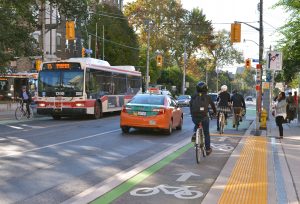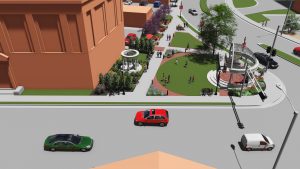Public Health and Planning. This symbiotic relationship stretches back to the dawn of civilization, with each subsequent generation making new and better-informed decisions about how to improve the well-being of their people. Join us for a new series that examines the history, impacts, current issues and best practices of planning for public health.
Part I: Intersections of Health and the Built Environment
The expansive domains of public health and community planning impact the physical and mental well-being of people around the world. Throughout history, the two fields have worked together to progress sanitation systems and improve living conditions — leading to measurable improvements in outcomes such as mitigation and containment of communicable diseases, cleaner air and water, and overall happier, healthier citizens. It is important to consider this relationship and all the places public health and planning intersect. Doing so will help communities decide when and where to invest limited resources to generate the greatest impact.
Countless Connections, Measurable Outcomes
Almost every aspect of the built environment and our socioeconomic systems impact the health and well-being of — well, everyone!
Transportation
Transportation systems impact physical activity and access to essentials such as health care, employment and basic resources. They can also impact the air and water quality of the environments in which we live, work, and play — resources that impose health determinants upon everyone, no matter their engagement level. As planners, it is important to help communities develop sustainable, barrier-free transportation networks with public transit options that serve citizens from door to door, no matter their age or ability. It is also critical to plan for the transportation of tomorrow, with infrastructure to accommodate more electric and autonomous vehicles, bicycle, pedestrian and e-bike routes, and modes of transit supported by clean energy.
Transportation projects can be expensive to fund. However, the costs generally peak during construction while continuing to reap benefits for decades thereafter. There are also some innovative new funding programs to assist, such as the 2022 Reconnecting Communities Pilot (RCP) program — funded through the Bipartisan Infrastructure Law (BIL) — which helps reconnect communities divided by antiquated transportation systems by awarding grants for planning or construction.

Photo: Nicola Betts, Wikimedia Commons
Water and Waste Systems
A common attribute and mark of great civilizations is the development of water and sanitary systems. From evidence of Neolithic-era water wells and the primitive indoor wastewater systems of Scotland’s Skara Brae, to the first sanitation sump in 4000 B.C. Babylon and the more sophisticated developments of the Roman Empire, water and waste systems have always formed a critical foundation of community health.
Advancements in water and sanitation systems have played a crucial role in regulating diseases of the past, such as typhoid and cholera. Today, we largely rely on chronic disease indicators (CDI) developed by the Centers for Disease Control and Prevention (CDC) to collect and uniformly define data related to communicable diseases and their impacts on public health. However, this can exacerbate the challenge of assessing human health through the built environment, even though we’re keenly aware that our built environments do impact some of our most blatant health threats such as diabetes and heart disease.
Planners play a key role in assisting communities with capital improvement projects such as water and wastewater systems. These larger infrastructure projects are generally incorporated into community Capital Improvement Plans (CIPs), which are reevaluated and updated approximately every five years. Closely tracking the condition, maintenance needs and operational performance of these systems will better help community leaders plan and budget for improvements to keep these key community health systems running smoothly.
According to Hutton et al. (2007), the cost-to-benefit ratio of investments towards water and sanitation improvement ranged between 1:5 and 1:46. The most significant and impactful benefit was a time savings that also increased productive time. Although, the decrease in healthcare costs and mortality were certainly not negligible.
Green Spaces, Parks and Recreation
Community parks and green spaces also greatly impact our health, well-being and the broader environment. They improve air and water quality, reduce urban heat island effects to help mitigate global warming, and provide opportunities for recreational activity — which is known to have positive impacts on physical, social and mental health.
Health benefits of parks and green spaces can be less tangible to calculate, as are the perpetual benefits from greenspace and environmental improvements. Eden et al. (2022) analyzed health indicators of persons living in heavily tree-covered areas versus those living in barren neighborhoods between 2003 and 2015. The research revealed that persons inhabiting desolate areas spend $374 more annually on medical costs compared to their counterparts in lush conditions. Insurmountable annual impacts on residual symptoms including healthcare and greenhouse gas mitigation are immeasurable.
As planners, we are keenly aware of the need to incorporate green spaces and recreational amenities into community plans. No matter the size of the community or the availability of property at hand, parks and green spaces can be readily introduced in any environment — from pocket parks in dense urban settings to the establishment of large regional recreational plans and trail networks.

Third Places
The term “Third Places” was first coined by sociologist Ray Oldenburg in his book, “The Great Good Place.” It refers to social surroundings where people tend to gather outside of their ‘first’ place (home) and ‘second’ place (work): coffee shops, libraries, community centers, barber shops or parks — places that provide opportunities for recreation and socialization. Oldenburg maintains that these community gathering spots are important for civil engagement, creative interaction and establishing a sense of belonging.
Land Use and Zoning
Health impacts are correlated to factors that may seem less consequential for individuals, too. Although our land use regulations are primarily perceived as development and design tools, they have a significant impact on the health of individuals within communities. The reasoning was possibly more obvious during the industrial era when heavily contaminating factories and mining sites were recognized as concerns to human health — instigating the justification and legal basis for regulating land uses and enabling zoning policies. Today, we face similar threats with hazardous sites that we rely on every day, such as fueling stations. Chemicals found in these materials such as benzene increase risks of developing cancer throughout one’s lifetime and are more dangerous for at-risk populations such as children and the elderly. States and counties from California to Maryland have adopted regulations to address these concerns by placing fueling stations the recommended 500 feet from residences, schools, daycares, playgrounds, and other sensitive uses (Hsieh et al., 2021).
Mental Health is Physical Health
Less tangible measures of our planning strategies include mental health impacts. And less predictive alternatives are policy updates. Individuals are less likely to report mental health needs than physical health needs, thus improvements are less likely to be documented. Not to mention that many individuals aren’t aware of the impacts of the built environment on their mental health. It’s much simpler to deduce the causation of physical disease than mental health issues. For example, we’re aware of preventative measures for heart disease, but we’re not always in control of emotional and mental consumption that impacts our mental health. We can track our eating and exercise habits, but we don’t always have the option to reduce a stressful commute, increase organic social interaction or alter other stressors.
As planners, we can help assure the entirety of the human being is tended to when making impactful decisions about community layout, development, transportation networks and access to all modalities of health care — physical and mental alike.

Tools for Cooperation
Planning and public health professionals have a myriad of tools available to help mitigate health impacts from the built environment. GIS can enhance epidemiological studies and identify sources of contamination and contagions that are harmful to human health. Health impacts can also be identified in early stages of program and policy implementation by incorporating health impact assessments (HIA) into general practices. These tools help to assess what the outcomes of various programs, projects and policies will be for different populations. These range from in-depth analyses to quick checklists and generally follow this series of steps: screening, scoping, assessment, recommendations, reporting, monitoring and evaluation (CDC.gov).
A Partnership for Change
Combined efforts between public health and community planning have long benefited human health. Water and sanitary systems, transportation, greenspace and policies all influence individual and collective health in our communities. But as our societies adopt increased nuances, and as societies evolve, so too must our partnerships and efforts.
Part II in our “Intersections of Health & the Built Environment” series takes a closer look at green spaces and third places — and how they promote health through recreation and socialization opportunities.
